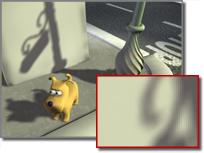
Glossary

Example of shadow-mapped shadows
A shadow map is a bitmap that's projected from the direction of a light source. Shadow maps don't show the color cast by transparent or translucent objects. On the other hand, shadow maps can have soft-edged shadows, which ray-traced shadows cannot. This method can require less calculation time than ray-traced shadows, but it's less accurate.
You can adjust the shadow map settings to achieve a sharper shadow. This involves changing the resolution and the pixel sampling of the shadow's bitmap. Because shadow-map shadows are only bitmaps, you need to keep in mind their resolution in relation to your distance from the shadow, and the detail required by the shadow. If the resolution is too low, and the camera too close, the shadow might look more like sooty smudges.
If shadows appear too coarse, increase the map size. The size can range from 0 to 10,000. However, be aware that greater size requires more memory and can take longer to generate. A 4096-line shadow map occupies 64 MB of memory (4096 x 4096 x 4).
The default shadow map size is 256.
The bitmap used by shadow maps must fill the area covered by the falloff of the spotlight. The wider the falloff, the coarser the shadow appears. Keep the falloff as tight as possible given the requirements of your scene.
Note: The gmax viewports don't display shadows, and cannot show the effect of this feature. Your target game engine might or might not provide support for shadow maps.